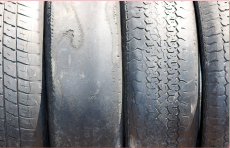
Reading Your Tire Wear
Different problems leave distinct patterns
Catching tire wear early on can add thousands of miles
to tire life, saving you thousands of dollars. The kind of
wear on your tires can also let you know what the problem
is, whether the problem is with the tire itself or with your
truck's alignment, and how best to mitigate it going forward.
Here are a few common examples of tire wear, what they
mean, and how you can avoid them.
Thrust or scrub angle wear
If the inside of one drive tire is wearing thin before the
other, this is called thrust or scrub angle wear. It is caused
by improperly aligned drive axles and causes the truck to
veer to the right or left depending on which tire is impacted.
Unparallel wheels on an axle make one tire roll in a larger
diameter. Properly aligning your drive tires will correct
scrub or thrust angle wear.
Dog tracking
Similar to thrust angle wear, improper alignment of a
tractor's rear axles with the trailer axles leads to dog
tracking, which will cause the trailer to veer from a straight
direction. If your truck is pulling to one direction while
traveling in a straight line, your rear tires may be suffering
from dog tracking. Making sure a trailer's rear axles are
aligned correctly will fix dog tracking.
Sidewall damage
Excessive curbing and abnormally heavy loads can
damage your tires' sidewalls. Keeping yourself from hitting
the curb while parking is the most effective way to keep
your sidewalls strong and wear free, but you should also
make sure that you're hauling only weights your truck can
handle.
Tire camber
Improper camber will lead to uneven tread wear. Positive
camber happens when a tire is titled out, resulting in
smooth wear on the outside of tires. Negative camber is the
opposite—tires are tilted in at the top, leading to smooth
wear on the inside of tires. Aligning the tires to factory
camber specs will produce even wear across the tire.
Cupping wear
If sections of your tires are constantly not making contact
with the road, this can lead to cupping wear. High and low
spots of tread wear will occur as only parts of the tire are
actually hitting the road. Worn ride control or suspension
components are often the culprit of cupping wear, and it
can also mean that your truck needs new shocks.
Flat spotting
Aggressive braking, panic stops, or a locked or dragging
brake can lead to flat spotting. This is when a lone patch of
tread creates a flatter area than the rest of the tire surface.
Flat spotting is best avoided by braking properly. The less
aggressive you are with your brakes, the less you will have
to deal with flat spotting.
Toe or feathered wear
When small spots of wear start crossing your tread in
a diagonal pattern, you're dealing with feathered or toe
wear. Mismatched or improperly inflated tires, differing tire
diameters, worn bearings, and improper alignment are
all causes of toe or feathered wear. Maintaining proper
alignment and inflation should keep this kind of wear to a
minimum.
Tire wear is serious business. It can lead to blowouts,
wrecks, injury, or worse. By knowing what causes common
tire wear, you'll be better prepared to handle it. If you've
noticed any of these wear patterns on your tires, bring your
truck into Tredroc. We'll be able to correct the cause and
make sure it doesn't happen again.